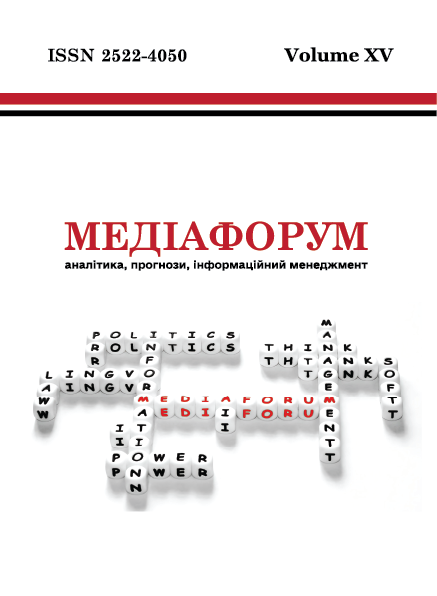The Religious Factor of Sovietization in Western Ukraine
DOI:
https://doi.org/10.31861/mediaforum.2024.15.350-362Keywords:
Sovietization, repression, Greek Catholic Church, Lviv Cathedral, ProtestantismAbstract
The article examines the process of destruction of the Ukrainian Greek Catholic Church by the Soviet authorities in western Ukraine, as well as repressive actions against Protestant religious organizations. The Soviet leadership viewed the Greek Catholic Church as a potential source of pro-Western political influence and propaganda. In order to make such processes impossible in the future and to prevent the aggravation of relations between believers by the Soviet authorities, it was decided to liquidate the UGCC. The authorities tried to give this church action the appearance of church canonical principles. This is how the initiative of some priests about the entry of the UGCC into the Russian Orthodox Church arose.
In March 1945, instructions on the liquidation of the Greek Catholic Church were prepared. It provided for the creation of the Lviv-Ternopil Orthodox Diocese, the transfer of the Uniate Cathedral in Lviv to it, the deployment of missionary work among Greek Catholic believers, and most importantly, the creation of an initiative group within the Greek Catholic Church that was to announce a break with the Vatican and call on the Uniate clergy to transfer to Orthodoxy. This instruction was personally approved by Y. Stalin. The work on the liquidation of the UGCC was led by the Central Committee of the Communist Party (b) of the USSR and the bodies of the Ministry of Internal Affairs of the USSR.
Under these conditions, on May 28, 1945, the Central Initiative Group for the Reunification of the Greek Catholic Church with the Orthodox Church was created in Lviv.
With the support of party-state bodies and the Ministry of Internal Affairs, the initiative group managed to subjugate the majority of priests in a short time. As of January 1, 1946, 859 priests out of 1,294 (that is, 66%) supported it.
On March 8-10, 1946, the Central Initiative Group held a meeting in the Cathedral of St. Yura in Lviv UGCC Cathedral. 216 priests and 19 laymen of the UGCC, a delegation of the Russian Orthodox Church took part in this Council. The Lviv Council proclaimed the abolition of the Union of Brest in 1596 and the "reunification" of the Greek Catholic Church with the Russian Orthodox Church. The Uniate church parishes were transferred to the Orthodox Church. 590 Greek Catholic priests refused to recognize the council's decision, 344 of them were arrested and convicted.
There is no doubt that the Lviv Council in March 1946 was not canonical, since the head of the church and its bishopric did not agree to its holding, and even more so to its adoption of any decisions. The non-canonicality of the cathedral also lies in the fact that the priests of the UGCC were openly pressured by the party structures and bodies of the MDB.
Downloads
References
Botsiurkiv B. 2005. Ukrainska Hreko-Katolytska Tserkva i Radianska derzhava (1939-1950). Lviv: Vydavnytstvo Ukrainskoho Katolytskoho Universytetu. S. 65.
Voinalovych V., Kochan N. 2018. Relihiinyi chynnyk etnopolitychnykh protsesiv u Halychyni: povoienna radianska doba i suchasnist. Kyiv: IPIiEND im.. I. F. Kurasa NAN Ukrainy. S.11, 69, 97.
Hurkina S. 2012. Hreko-katolytske dukhovenstvo Lvivskoi arkhyieparkhii v umovakh peresliduvannia radianskoiu vladoiu (1944-1950 rr.) // Avtoreferat dysertatsii kandydata istorychnykh nauk: 07.00.01. Lvivskyi natsionalnyi universytet im. Ivana Franka. Lviv. S. 20.
Dashkevych Ya. . 1998. Likvidatsiia Virmeno-katolytskoi tserkvy v Halychyni 1945 r. Istoriia relihii v Ukraini. Materialy VIII mizhnarodnoho kruhloho stolu. (Lviv, 11-13 travnia 1998 roku). Lviv: Lohos. S. 84-86.
Ukrainska hreko-katolytska tserkva. URL: https://uk.wikipedia.org/wiki
Tsentralnyi derzhavnyi arkhiv vyshchykh orhaniv vlady i derzhavnoho upravlinnia Ukrainy (dali – TsDAVO Ukrainy). F. 4648. Op. 3. Spr. 65. Ark. 76.
Tsentralnyi derzhavnyi arkhiv hromadskykh obiednan Ukrainy (dali – TsDAHO). F.1. Op. 23. Spr. 1639. Ark. 87-90.















